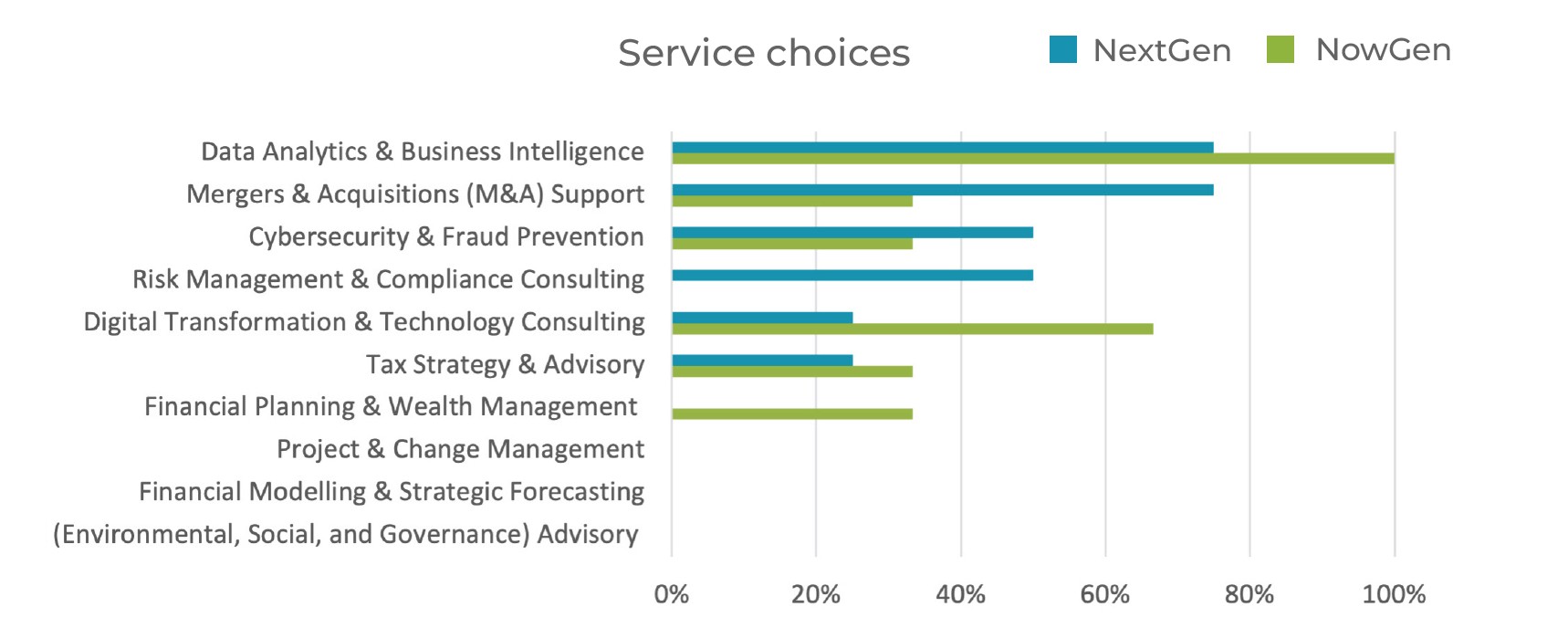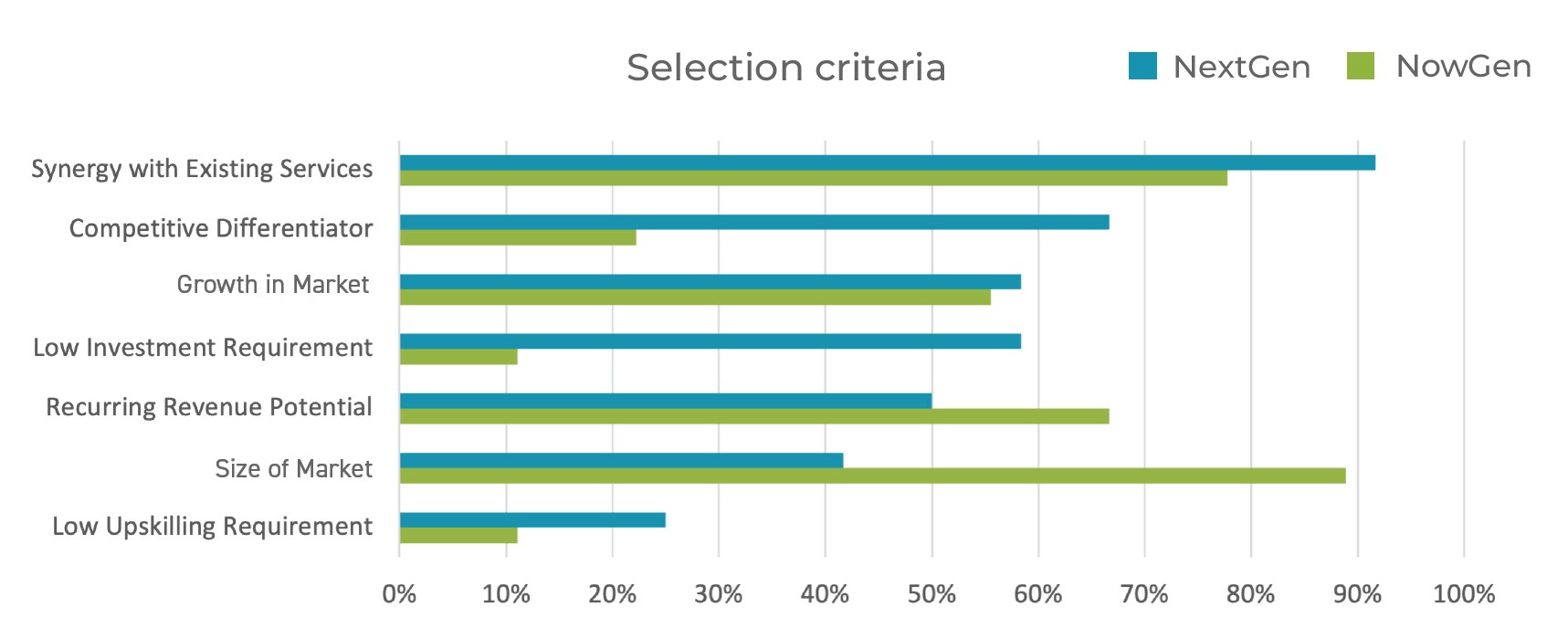Our latest edition of Global Business Voice, Generational Influence on Strategy, uncovers how different generational responses signpost the need to perhaps reassess how we integrate generations in strategic planning.
Introduction
This year’s AGN Excellent+ conference brought together both NextGenners and NowGenners, highlighting generational contrasts in strategic thinking. AGN split participants into the two generational groups for a ‘Service Evolution’ workshop where both groups tackled a fictitious case study (Greenfield & Co), leading to fascinating differences in outcomes and approaches.
On the move?
Tune into our mini podcast on Spotify at the end of this article for a quick summary of the key insights.
Immediate Takeaways for AGN Members
The AGN Excellent+ conference highlighted the distinct ways different generations approach strategy and innovation. Four key takeaways emerged to help firms adapt to changing markets and generational dynamics.
1. Include Multi-Generational Voices in Strategic Planning
NextGenners have ideas that reflect future client expectations and emerging risks. Firms that fail to include these voices risk becoming irrelevant.
2. Blend Short-Term Gains with Long-Term Investment
NowGen’s focus on profitability is vital—but not at the cost of future growth. Ensure automation and advisory development are adequately resourced.
3. Rethink M&A as the only Growth Lever
While consolidators favour M&A, NextGenners see growth through differentiation and capability-building. Test whether the NextGenners view is fear of the unknown or more evidence of the value they place on culture and continuity.
4. Prioritise People Over Process
The clearest NextGen insight? People matter. If you want to transform services, invest in the skills to deliver them. Upskilling isn’t a luxury—it’s a core strategy.
The Greenfield & Co Strategic Challenge (Fictitious Case Study)
Greenfield & Co, a respected UK accountancy
firm, faced mounting pressure to modernise
as 90% of its revenue depended on traditional
compliance services. Leadership issued a
transformation challenge: move towards
advisory services, automation, staff
development, and new investments.
The firm asked two generational cohorts—NextGen and NowGen—to prioritise three advisory services from a longlist, justifying their choices based on factors like market potential, investment needed, and fit with current offerings. Both groups then allocated a ₤5 million budget across five areas: automation, upskilling/hiring, branding, internal
growth/M&A, and other innovations. Each group also crafted a motivational statement to drive transformational change, with responses scored and compared to highlight generational differences.
Task 1: Advisory Service Priorities: Who Chose What?

Advisory Service Priorities — Who Chose What?
The NextGenners have chosen to focus on ESG, Data Analytics, and Cybersecurity—domains that not only showcase technological advancements but also reflect societal and generational priorities. These choices indicate a forward-looking perspective where digital proficiency and social responsibility are prioritised – their choices perhaps reflecting their lived experience and view of future
challenges.
NowGenners, meanwhile, leaned into Tax Strategy, Wealth Management, and M&A—service lines grounded in today’s market demand, revenue certainty, and compatibility with existing firm capabilities. These selections seem to signal a desire to evolve incrementally from a known base, preserving value while pivoting strategically.
Generational Insight:
Does this divergence in service focus reflect more than a preference? Does it actually reveal a philosophical gap between generations? NextGenners are prioritising relevance, differentiation, and innovation, motivated by longer horizons and the urgent need to stand out. NowGenners are grounding strategy in what’s bankable, defendable, and proven. They are looking for commercial wins that preserve legacy and generate return within the tenure of their leadership.
Task 1a: Strategic Reasoning Behind Service Selection
The case challenge required each group to justify their chosen advisory services using seven evaluation criteria:

When asked to justify their service priorities using criteria like market size, ease of implementation, and potential for differentiation, the two generations appear to apply quite different filters.
- NextGenners rated criteria like “growth potential,” “competitive edge,” and “future readiness” as paramount—even when those came with high investment requirements or steep learning curves.
- NowGenners chose services based on what could be deployed quickly and with minimal disruption— prioritising “synergy with current offerings,” “ease of delivery,” and “staff capability.”
Strategic Mindset Difference:
What can we draw from all this? If nothing else it’s clear there is generational difference in strategic reasoning:
- NextGenners are designing for tomorrow’s firm. They seem comfortable with ambiguity, more willing to build new capabilities, and believe long-term advantage justifies short-term discomfort.
- NowGenners appear intent on protecting today’s firm, their choices aiming to extend value from existing competencies and relationships, shaping strategy around the efficient use of today’s resources.
Key Example:
NextGen’s choice of Cybersecurity—despite its low synergy and high skills demand—shows an instinct to disrupt and differentiate. NowGen’s selection of Tax Strategy, a trusted revenue generator, reveals a focus on familiar disciplines and scalability.
Task 2: Investment Allocation: How to Spend £5 Million?
The Greenfield case study asserts that to successfully navigate this transformation, the teams must allocate resources strategically, and over the next five years, there is £5 million available to invest across the following areas:
- Automation of Processes – Implementing AI-driven tools, cloud-based accounting platforms, and automated audit solutions.
- Staff Upskilling & Hiring – Training existing staff in new technologies and hiring specialists in data analytics, ESG, and digital transformation.
- Branding and Market Positioning – Elevating Greenfield & Co’s reputation as a forward-thinking, advisory-led firm.
- Internal Development or M&A Strategies – Investing in new service lines internally or acquiring niche firms with expertise in high-growth areas.
- Other Innovative Initiatives – Exploring new business models, such as subscription-based advisory services or partnerships with fintech firms.
As with the other areas of the challenge, the different generations took a contrasting approach to how they would invest the available funds.
- NextGenners directed the bulk of the investment toward people: upskilling, hiring, and innovation. It could be said that their approach reflects a strong belief in internal capability development and long-term cultural transformation.
- NowGenners, conversely, favoured external levers—most notably allocating significant sums to M&A and brand repositioning. Their approach emphasised structural change, strategic control, and the amplification of existing assets.
This contrast illustrates two quite different approaches to organisational change management and transformation:
- NextGenners see transformation as organic and iterative—driven by people, culture, and knowledge capital.
- NowGenners see it as structural and capital-intensive—driven by strategic transactions and market optics.
It’s unlikely that one generation fears change more than the other, but it could be that they conceptualise change differently.

Key Example:
NextGen’s ask “Who do we need to become?” While NowGen ask “what do we need to acquire?”. Both are legitimate and necessary perspectives, but without dialogue they can create disconnects in transformation strategy, budget priorities and even succession planning. There seems to be a recurring theme in the NextGenners response which points to a more inward and empathetic perspective, versus the NowGenners.
Summary of Differences – A Generational Matrix

These differences reveal more than tactical divergence—they reflect different ways of thinking about what strategy is. The results of this exercise at least signal that for many NextGenners, strategy is about relevance and reinvention, and for NowGenners, it’s more about risk, revenue, and rationalisation.
Summary of Differences – A Generational Matrix
1. Include Multi-Generational Voices in Strategic Planning
NextGenners have ideas that reflect future client expectations and emerging risks. Firms that fail to include these voices risk ignoring a highly valuable resource.
Why this Matters: The generational lens reveals both strategic blind spots and hidden opportunities. Gen Z and younger Millennials—AGN’s NextGen—are digital natives and ethically conscious professionals who value purpose, technology, and rapid feedback. Their perspectives are deeply shaped by global crises, environmental urgency, and a hyper-connected digital economy.
AGN Perspective: The AGN GBV ‘ESG Part II’ report highlights how Gen Y and Z employees are more attuned to ESG values, and how meaningful work is a crucial retention factor. AGN’s Women of Impact and NextGen programs offer platforms for these voices.
Recommendation: If your firm’s five-year plan was co-authored by your most visionary 28-year-old, what would be different? Incorporate structured multi-generational workshops into strategy cycles—such as co-authoring vision statements or road-testing advisory services with NextGen panels.
2. Blend Short-Term Gains with Long-Term Investment
NowGen’s focus on profitability is vital—but not at the cost of future growth. Ensure automation and advisory development are adequately resourced.
Why this Matters: The tension here is generational—but also philosophical. Many NowGenners (typically equity-holding partners) rightly prioritise EBITDA, but are they at risk of underinvesting in digital tools, advisory services or L&D for fear of denting margins?
AGN Perspective: The AGN Digital Maturity Diagnostic shows 32% of firms feel far behind competitors (technologically); yet most underutilise AI and automation, particularly in audit and advisory transformation. The AGN Advisory Migration Methodology stresses that long-term firm value increasingly depends on developing consulting skills, understanding emerging sectors, and delivering data-driven advisory—not just compliance.
Recommendation: Caution: don’t maximise today’s margin at the expense of tomorrow’s relevance?
Adopt a “dual horizon” investment approach—tactically improve margins through efficiency (e.g., outsourcing, Robotic Process Automation, AI), while ringfencing a strategic growth budget for digital tools, service development, and client experience.
3. Rethink M&A as the Primary Growth Lever
While NowGenners favour M&A, NextGenners see growth through differentiation and capability-building. These ideas aren’t mutually exclusive—but they need sequencing and integration.
Why this Matters: We’ve seen that M&A is the primary tactic amongst industry ‘consolidators’ to create scale, market share, and short-term value—especially with PE funding. But NextGenners point instead to culture, ESG alignment, and digital service differentiation as the real growth drivers.
AGN Perspective: The GBV on Business Value details two distinct strategic archetypes: “scale and exit” vs. “legacy and excellence”. Many AGN firms fall somewhere between the two and generational conflict emerges when one side dominates. M&A can be culturally disruptive; it risks alienating younger talent if capability-building, upskilling, and tech integration lag behind the deal.
Recommendation: What if your growth strategy was defined by your most differentiated services, not just your footprint? Integrate growth sequencing models into strategic plans—use M&A to acquire new capabilities, then follow with deep service innovation, staff enablement, and client co-creation processes.
4. Prioritise People Over Process
The clearest NextGen insight? People matter. If you want to transform services, invest in the skills to deliver them. Upskilling isn’t a luxury—it’s a core strategy.
Why this Matters: NextGenners see people strategy as strategy—not just HR policy. Other research indicates they value upskilling, meaningful work, psychological safety, and purpose-alignment more than previous generations. This is not just a recruitment issue; it’s a retention, innovation and brand issue.
AGN Perspective: The GBV on Employer Brand (Q Concepts case) is a blueprint for this thinking: flat hierarchies, self-directed teams, coaching cultures, and personalised L&D.
Recommendation: If skills and engagement become the primary competitive advantage in 2030, are you ready? Turn your L&D agenda into a firmwide transformation tool. Deploy NextGen-led training (as seen in Road to Rome challenges, AGN Next Leaders series, AGN AI Masterclass and Excellent+, introduce AI/automation training tracks, and link career development to the firm’s strategic advisory roadmap.
Conclusion
The Greenfield & Co case study offered a structured way to explore how two generations within our firms
view strategic transformation. The results underscore a central truth: your firm’s future will be shaped
not just by what you invest in but by who gets to make those decisions.
Are you hearing the voices of your future leaders?
NowGenners, seasoned partners and leaders, were invited to Excellent+ in May 2025 because the timing of 2025 World Congress clashed with the traditional timing of the EMEA Regional Conference. Excellent+ was thought to be a great extra opportunity for the core regular AGN contact partners to learn, connect with associates and do business.
Useful AGN Reference Materials:
Mini podcast
Tune into our mini podcast on Spotify for a quick summary of the key insights.
For further information on this topic or anything relating to the AGN International Association of Accounting and Advisory Firms or to become an AGN member, please email your closest AGN Regional Director (see below) or go directly to www.agn.org.
Malcolm Ward
CEO AGN International
mward@agn.org
Jean Xu
AP Regional Manager
jxu@agn.org
Marlijn Lawson
EMEA Regional Director
mlawson@agn.org
Cindy Frey CPA, CGMA
Americas Regional Director
cfrey@agn.org
Copyright © 2025 AGN International Ltd. All rights reserved. No part of this publication may be reproduced, distributed, or transmitted by non-members without prior permission of AGN International Ltd.




